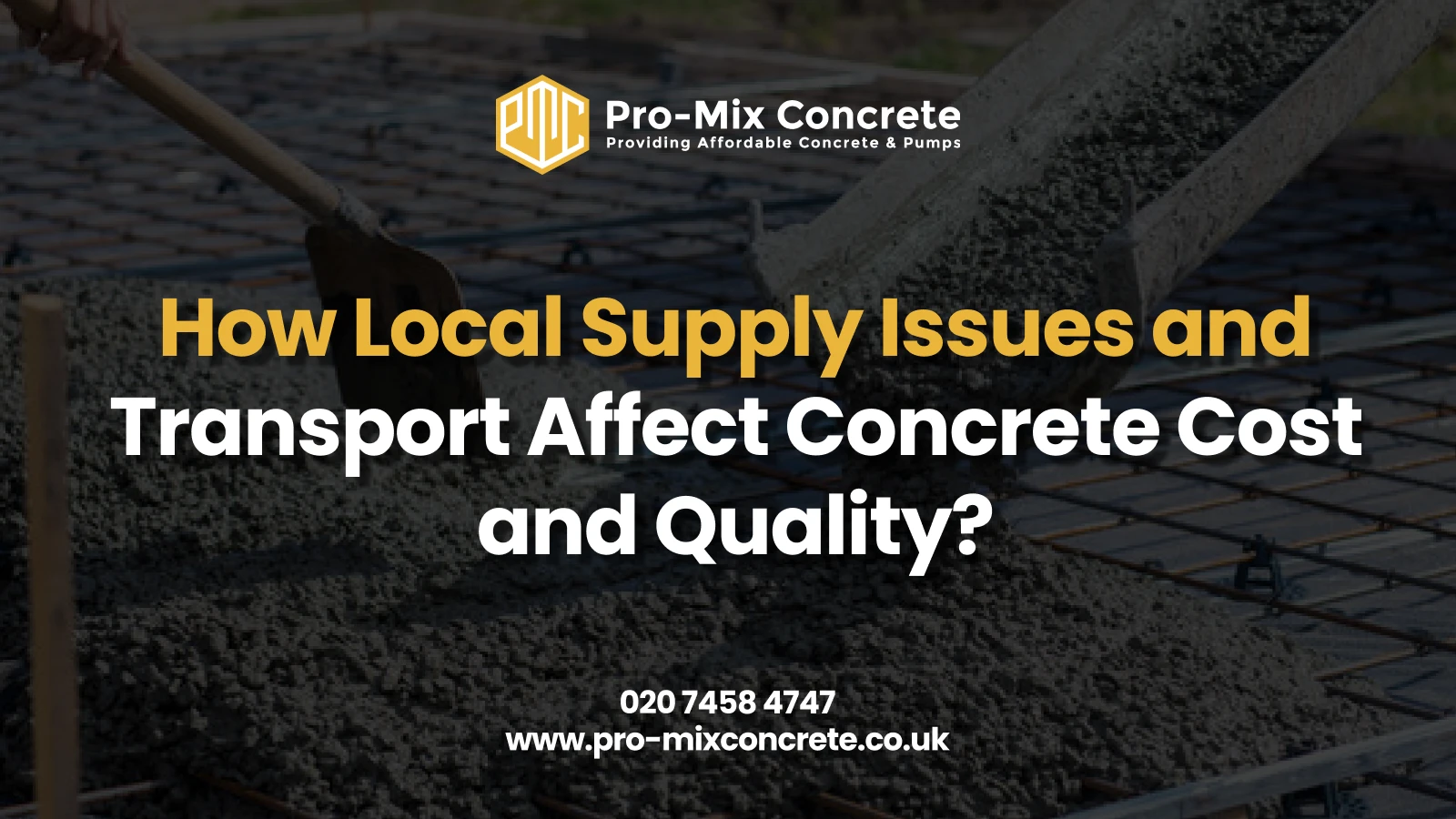Supply and delivery issues can quickly throw off project budgets and quality. When local supply runs short, you may have to buy concrete from far away, raising costs and risking faster set times. Long trips mean moisture loss, separation, and wasted loads. Choosing nearby suppliers helps keep prices low and quality high. Careful planning, reliable partners, and good scheduling save money and prevent last-minute surprises.
Budgets and schedules live or die by concrete availability and delivery timing. Supply shortages slow projects. Transport delays can turn usable concrete into wasted loads. Smart builders choose suppliers for reliability, not just price, to keep work moving. When local concrete suppliers encounter raw material shortages, contractors face difficult choices between project delays and premium pricing. Distance matters not just for cost calculations, but for maintaining the chemical and physical properties that ensure structural integrity. Smart builders recognise these interdependencies and plan accordingly, selecting suppliers based on reliability networks rather than quotes alone. Success requires understanding how geography, timing, and supply networks converge to shape both expenses and results.
Get access to Pro-Mix Concrete’s ready-mix and on-site concrete solutions for residential, commercial, and industrial projects across the UK. Same-day and next-day delivery available.
Order Your Ready Mix Concrete Now: 020 7458 4747
What Factors Affect Concrete Cost?
Concrete prices depend on several factors, like material costs, labour rates, delivery distance, and local demand. Prices can vary a lot by region, so getting local quotes is key to setting a realistic budget.
1. Material Quality and Local Availability
Concrete begins with cement, aggregates, water, and chemical admixtures. Source proximity determines whether contractors access stable pricing or face volatile markets. Regional quarries and cement facilities operating at capacity create predictable cost structures. When local materials run out, you have to buy from farther away, and every extra mile adds to the final cost.
Key Cost Impacts Include:
- Cement availability: Facility shutdowns redirect purchasing to remote plants
- Aggregate quality: Superior local stone eliminates imported material premiums
- Water source accessibility: Site-available water avoids trucking charges
- Admixture pricing: Chemical distribution networks vary regionally
2. Local Market Demand and Pricing Volatility
Construction surges strain inventory, pushing rates upward as local concrete suppliers balance limited capacity against competing orders. Simultaneous project starts create bidding wars for available supply.
Seasonal Demand Patterns Show:
- Spring and summer: Activity peaks command premium rates
- Winter slowdowns: Reduced schedules enable negotiated discounts
- Infrastructure projects: Government contracts absorb regional output
- Regional development: Housing expansions trigger unexpected shortfalls
Quotes expire rapidly in hot markets where capacity constraints shift daily pricing structures.
3. Labour Costs and Market Conditions
Technical expertise drives wage premiums. Batch plant operators require certifications, mixer drivers need specialised licenses, and both professions face workforce shortages that elevate compensation expectations. Workforce scarcity flows directly into customer invoices as suppliers compete for skilled personnel.
Labour Cost Factors:
- Driver shortages: Qualified operators negotiate higher hourly wages
- Plant operators: Certified technicians command premium salaries
- Regional wage differences: Metropolitan rates restrict rural compensation
- Overtime requirements: Rush orders trigger multiplied pay scales
4. Freight and Transportation Costs
Delivery distance raises costs fast. Every extra mile means more fuel, driver hours, and equipment wear, all added to your bill. Diesel fluctuations create weekly surcharge adjustments, particularly impacting medium-haul deliveries where fuel represents a significant portion of expenses.
Distance-Based Pricing Typically Breaks Down As:
- 0-10 miles: Baseline delivery charge
- 10-25 miles: Per-mile surcharges activate
- 25-50 miles: Premium distance penalties
- 50+ miles: Economic feasibility collapses
What Factors Affect Concrete Quality?
Excellence emerges from premium inputs, precision batching, and careful handling. Production through placement, every step either maintains or destroys performance potential.
1. Raw Material Quality and Source
Geology dictates aggregate characteristics. Mineral composition, particle shape, and surface texture all vary by extraction location. Local concrete suppliers tapping premium quarries deliver consistency impossible with inferior sources.
Material Quality Indicators Include:
- Aggregate cleanliness: Clay coatings and organic residue weaken bonding
- Cement consistency: Manufacturing variations alter hydration chemistry
- Water purity: Dissolved minerals impact setting behaviour
- Aggregate gradation: Size distribution controls packing efficiency
2. Mixing and Batch Control
Automation eliminates measurement errors. Computerised systems weigh ingredients within tight tolerances, sensors adjust for moisture variations, databases reproduce proven formulations, and integrated labs verify strength parameters. Manual batching introduces inconsistency risks, especially when production pressures tempt operators toward speed over precision.
3. Transportation Logistics: Time, Equipment, and Distance
The 90-120 Minute Window
Concrete starts setting the second water is added. You typically have 90-120 minutes to place it. Any delivery delay cuts into that window and can ruin an entire load.
Transportation Quality Factors:
- Delivery time windows: 90-120 minutes usability limits
- Truck maintenance: Clean drums prevent contamination
- Mixing during transit: Controlled rotation maintains uniformity
- Temperature control: Climate adjustments preserve characteristics
Extended hauls multiply degradation exponentially under temperature stress.
Impact of Local Supply Disruptions
When one part of the supply chain breaks, delays pile up fast and costs rise. Knowing where your supply is most vulnerable helps you plan ahead and line up backup suppliers.
Supply Chain Disruptions: Fuel, Coal, Aggregates
Production requires converging inputs. Single failures propagate systemwide, creating regional scarcity despite adequate overall capacity.
Common Disruption Sources Include:
- Fuel shortages: Delivery zones contract, stranding distant customers
- Coal supply issues: Kiln operations slow, choking cement output
- Aggregate quarry closures: Equipment failures or permits halt extraction
- Admixture availability: Speciality chemicals become allocation-based
Interruptions stretch timelines while simultaneously spiking unit pricing.
Seasonal and Location-Based Demand Variability
Climate and geography create predictable pressure points. Savvy contractors time projects around known constraints, securing favourable terms.
Seasonal Challenges Include:
- Spring thaw: Winter backlogs unleash overwhelming demand
- Hurricane season: Storm repairs commandeer coastal capacity
- Agricultural cycles: Farm infrastructure competes for rural plants
- Tourism peaks: Visitor facilities absorb resort-area production
Secure your slot with our fast concrete delivery throughout the UK. Book your concrete pump hire service now.
Schedule Now: 020 7458 4747
Regulatory and Environmental Effects
Compliance standards reshape economics and capabilities. Neighbouring jurisdictions demonstrate vastly different cost structures based on environmental stringency. Stringent zones exhibit premium pricing reflecting compliance investments.
Regulatory Impacts Include:
- Emission controls: Pollution equipment raises capital and operating costs
- Noise ordinances: Hour restrictions shrink daily output windows
- Water discharge permits: Treatment systems add processing expenses
- Quarry restrictions: Habitat protections curtail extraction volumes
How Transport Affects Concrete Performance
Chemistry progresses inside rotating drums, setting advances, workability diminishes, and separation threatens. Success demands minimising exposure between batching and finishing.
Setting Times, Traffic, and Delivery Delays
Congestion creates unpredictability. Hydration continues regardless of location, stuck in traffic or ready for placement, chemical timers keep running.
Delay Consequences Include:
- Initial set beginning: Workability vanishes beyond 120-minute thresholds
- Traffic gridlock: Unpredictable congestion extends transit unpredictably
- Site access issues: Unready locations force extended waiting
- Weather changes: Temperature swings accelerate or retard reactions
Transportation problems generate substantial complaint volumes beyond production control.
Quality Risks During Long Distance Haulage
Distance multiplies exposure to degradation forces. Heat, agitation, and evaporation all intensify with extended transit, compounding performance losses. The farther concrete travels, the faster its quality drops. Twice the distance usually means more than twice the risk of hardening, separation, or water loss.
Distance-Related Risks Are:
- Segregation: Gravity pulls denser particles downward during rotation
- Water evaporation: Moisture loss concentrates the mix, reducing workability
- Temperature fluctuations: Thermal cycling disrupts reaction kinetics
- Over-mixing: Prolonged agitation destroys air bubble networks
- Contamination: Extended exposure invites debris introduction
Best Practices in Concrete Transport and Placement
Preparation and protocols prevent transport losses. Professional execution protects investments through systematic quality safeguards.
Professional Best Practices:
- Schedule strategically: Target low-traffic delivery windows
- Maintain equipment: Regular servicing prevents drum contamination
- Monitor temperatures: Insulation protects against climate extremes
- Communicate constantly: Real-time updates optimise coordination
- Prepare sites fully: Ready teams eliminate truck delays
- Use tracking systems: GPS routing avoids congestion zones
- Test upon arrival: Immediate verification confirms specifications
- Document conditions: Thorough records establish accountability
Disciplined implementation slashes rejection rates while ensuring compliance.
Local vs. Imported Concrete
Proximity versus distance involves complex tradeoffs. Project specifics dictate optimal sourcing, balancing economics, performance requirements, and availability constraints.
Cost, Quality, and Sustainability Differences
Local Concrete Offers:
- Cost savings: Eliminated haul expenses, reduced delivered pricing
- Quality assurance: Fresh batches preserve full performance potential
- Flexibility: Nearby sources accommodate last-minute adjustments
- Environmental benefits: Reduced emissions support sustainability goals
- Community support: Regional employment strengthens local economies
Imported Concrete Situations Include:
- Specialised mixes: Proprietary formulations unavailable nearby
- Capacity constraints: Local facilities maxed out
- Emergency supplies: Infrastructure damage forces distant sourcing
- Large-scale projects: Volume demands exceed regional production
Standard applications favour local concrete suppliers offering expertise, responsiveness, and consistent quality.
Takeaway
Buying local and planning delivery carefully is the best way to avoid wasted loads and budget overruns. Pick suppliers who are reliable and close by, not just the cheapest. The pros know that reliability and consistent quality save money in the long run.
Projects demanding reliability, consistency, and local knowledge find solutions with Pro-Mix Concrete. We connect supply efficiency with construction success through strategically positioned facilities, contemporary mixer fleets, and quality commitment, delivering on-time, on-spec materials ready for immediate use.
Connect with Pro-Mix Concrete for expert ready-mix concrete, mix-on-site solutions, and concrete pump hire for projects of any scale.
Call Us Now: 020 7458 4747
Frequently Asked Questions
How do local supply shortages affect concrete prices?
Local supply shortages increase concrete prices because suppliers must source materials from distant locations, raising transportation and logistics costs significantly per cubic yard.
Why does transportation distance matter for concrete cost?
Transportation distance impacts concrete cost through fuel consumption, labour hours, and delivery fees. Local sourcing proves more affordable as charges increase per mile.
How can transport delays impact concrete quality?
Transport delays cause premature hardening and segregation of concrete mix, resulting in poor workability and failed quality tests at construction sites.
What are the risks of using concrete delivered from far away?
Long-distance delivery risks include temperature changes, excessive mixing time, segregation, and water evaporation, which compromise strength, durability, and structural reliability.
Do local market conditions affect the availability and quality of concrete?
Yes. Local supply availability, demand fluctuations, and supplier reliability directly affect concrete cost and quality consistency throughout different seasons and project cycles.
What can be done to minimise concrete quality loss during transport?
Minimise quality loss by scheduling deliveries during off-peak traffic, maintaining trucks properly, monitoring temperature, using GPS optimisation, and testing upon arrival.
- Dennis Broderick
- Dennis Broderick is the founder and owner of Pro-Mix Concrete Company, a trusted name in ready-mix concrete solutions across the UK. With over 20 years of hands-on experience in the construction and concrete industry, Dennis brings unmatched expertise, practical insights, and a commitment to quality on every project - from residential driveways to large-scale commercial developments.
BlogOctober 19, 2025How Local Supply Issues and Transport Affect Concrete Cost and Quality?
BlogOctober 16, 2025Choosing the Best Mix Ratios for Durability in UK Climate Conditions
BlogOctober 15, 2025What Concrete Mix Strength is Needed for Safe Foundation Work in London
BlogOctober 15, 2025When to Use Concrete Screed vs Standard Concrete Floor?








